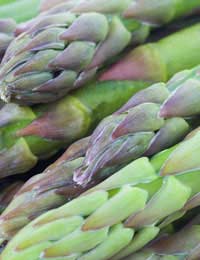
What to plant, store, and freeze from April to June – why not print these notes and keep them handy?
April to June: PLANTING
If you’re a vegetable grower, you may as well reserve all of your April weekends for planting and sowing. It’s the time of year when seedlings – and weeds – flourish in the warming soil, daylight hours lengthen and there’s always plenty of rain.
So you’ll be busy – nurturing seedlings indoors and outdoors, transplanting, weeding and even cropping your first veg of the year.
April:
- Globe Artichoke – the gourmet’s choice. Transplant young plants now; the first year’s harvest can be a bit iffy, but this perennial plant will produce if you persevere.
- Asparagus – plant asparagus roots as soon as they arrive from the suppliers, ensuring you’ve prepared the bed well – this perennial crop will stay put for up to 20 years.
- Carrot – continue sowing maincrop carrots, with protection against carrot fly.
- Cauliflower – transplant autumn-sown varieties.
- Celery – sow direct into trenches and keep well-watered.
- Wrinkled Peas – sow the maincrop varieties now.
- Maincrop Potatoes – plant direct, with slug or blight protection as necessary.
- Squashes – all varieties can be started indoors now. They will grow fast, ready to be transplanted after the last frost date.
- Spinach – sow summer and perpetual spinach direct.
May:
- French Beans – sow direct with slug protection.
- Beetroot – start this month, and stagger the sowings to avoid a big glut.
- Cabbage – transplant autumn-sown varieties.
- Courgettes – start off indoors or in a greenhouse.
- Spring onions – transplant seedlings from the nursery bed.
- Radish – continue with staggered sowing for a continuous crop.
- Swede – sow direct, with protection from cabbage fly and slugs.
June:
- Runner Beans – can be sown direct now, with plenty of homemade compost if you have it.
- Broccoli – ransplant plants for cropping next year.
April to June: STORING AND FREEZING
By June, there’s plenty to eat, and you’ll be enjoying most of your produce fresh. But don’t forget to put some into storage for rationing later in the year !
Spring Cabbage – eat fresh; does not store very well (but try to choose a no-bolt variety and it will stand well in the ground).
Celeriac – continue to harvest from the ground, covering with straw in case of a prolonged cold snap.
Corn Salad – if sown under cover, this hardy salad crop should continue to stand.
Garlic – use from stores; at this time of year the bulbs may start to shoot (it’s planting time – separate and plant some of your saved cloves!) but they are safe to eat (pick out the bitter green stem).
Leeks – finish the last few, either from your heeled-in trench or plot. Excess leeks will not freeze very well; instead, make leek and potato pasties and freeze them uncooked.
Kale – continue to harvest from the outside in; the plants will be reaching the end of their viability. To freeze the remainder, chop, blanch and squeeze out the kale; bag and freeze for use in stews and gratins.
Salad and Spring Onions – harvest and eat fresh; pick only the leaves, allowing the plant to give a second cut. If signs of bolting, cut the entire plant (don’t store).
Radish – harvest as required; don’t let them get too big and bitter. Pickle any excess for barbeques!
